Брошюра Нюрба просторная об объектах культурного наследия города Нюрба.
- Меню
- Главная
- Дошкольное образование
- Начальные классы
- Астрономия
- Биология
- География
- Информатика
- Математика
- Алгебра
- Геометрия
- Химия
- Физика
- Русский язык
- Английский язык
- Немецкий язык
- Французский язык
- История
- Естествознание
- Всемирная история
- Всеобщая история
- История России
- Право
- Окружающий мир
- Обществознание
- Экология
- Искусство
- Литература
- Музыка
- Технология (мальчики)
- Технология (девочки)
- Труд (технология)
- Физкультура
- ИЗО
- МХК
- ОБЗР (ОБЖ)
- Внеурочная работа
- ОРК
- Директору
- Завучу
- Классному руководителю
- Экономика
- Финансовая грамотность
- Психологу
- ОРКиСЭ
- Школьному библиотекарю
- Логопедия
- Коррекционная школа
- Всем учителям
- Прочее
Создайте Ваш сайт учителя Видеоуроки Олимпиады Вебинары для учителей
- Главная
- Английский язык
- Прочее
- Брошюра Нюрба просторная
Брошюра Нюрба просторная
Просмотр содержимого документа
«Брошюра Нюрба просторная»
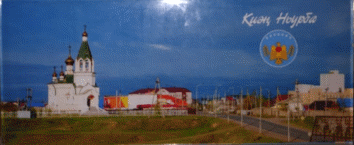
Нюрба просторная
Spacious Nyurba
Нюрба 2024г.


1.Памятник Ленину | Monument of Lenin |
Родился 22 апреля 1870 году в г. Симбирске (г. Ульяновск). Российский революционер, крупный теоретик марксизма, советский политический и государственный деятель, создатель Российской социал-демократической рабочей партии (большевиков), главный организатор и руководитель Октябрьской революции 1917 года в России, первый председатель Совета Народных Комиссаров (правительства) РСФСР, создатель первого в мировой истории социалистического государства. 28 октября 1967 года в поселке Нюрба в центре района был установлен скульптурный памятник В.И. Ленина в честь 50-летия Октябрьской революции и присвоения имени Ленина Нюрбинскому району. До этого памятник стоял на территории парка культуры и отдыха в г. Якутск. | He was born on April 22, 1870 in the town of Simbirsk (the town of Ulyanovsk). Russian revolutionary, major theorist of Marxism, Soviet political and state leader, founder of the Russian Social-Democratic Labor Party (Bolsheviks), main organizer and leader of 1917 October Revolution in Russia, first chairman of the RSFSR Council of People's Commissars (Government), creator of the first in world history socialist state. October 28, 1967 in the village of Nyurba in the center of the district was established sculptural monument V.I. Lenin in honor of the 50th anniversary of the October Revolution and the appropriation of the name of Lenin Nyurba district. Prior to this, the monument stood on the territory of the Yakutsk Culture and Recreation Park.
|
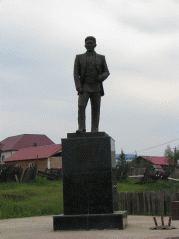

2.Памятник Степану Васильеву | Мonument of StepanVasiliev |
(1896, Нюрбинский район — 1943) — советский государственный и общественный деятель, руководитель группы тяжёлой промышленности Комиссии партийного контроля при ЦК РКП(б).Член Центральной контрольной комиссии ВКП(б) (1927—1934). Окончил в 1915 году Кобяйское двухклассное училище Нюрбинского улуса. Будучи студентом, принимал активное участие в революционном движении. После установления советской власти в 1918 году в Якутске стал секретарем Президиума Совета рабочих депутатов. Он является одним из организаторов Иркутского, Якутского комсомола. В 1921-1925 г.г учился в Москве в Коммунистическом университете им. Я.М. Свердлова. Работая в Москве в центральных органах партии правительства, оказал большую помощь в развитии Алданской золотодобывающей промышленности. Памятник был установлен в 1970-е годы.
| (1896, Nyurba District - 1943) - Soviet state and public figure, head of the heavy industry group of the Party Control Commission under the Central Committee of the RCP (b). Member of the Central Control Commission of the CPSU (b) (1927-1934). He graduated Kobya two-year school of Nyurba ulus in 1915. As a student, he took an active part in the revolutionary movement. After the establishment of Soviet power in 1918 in Yakutsk, he became secretary of the Presidium of the Workers' Deputies Council. He is one of the organizers of Irkutsk, Yakutsk Komsomol. He studied in Moscow at the Communist University. Y.M. Sverdlov in 1921-1925. Working in Moscow in the central organs of the government party, he rendered a great help in the development of the Aldan gold-mining industry. The monument was erected in the 1970s.
|
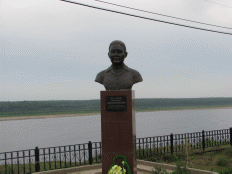

3.Бюст Александре Яковлевне Овчинниковой | Bust of Alexandra Yakovlevna Ovchinnikova |
(1914, Нюрбинский район — 2009) — советский партийный, государственный деятель, заместитель Председателя Президиума Верховного Совета РСФСР. Родилась 25 декабря 1914 года (7 января 1915) в Тыалыкинском наслеге Мархинского улуса Якутской области[. После окончания в 1934 году дорожного техникума работала на строительстве дороги Сунтар — Кемпендяй. С 1935 года 17 лет проработала в аппарате республиканского дорожного управления. В 1953 году закончила двухгодичную партийную школу и была назначена начальником Группы дорожного хозяйства, транспорта и связи Совета Министров ЯАССР, затем заведующей промышленно-транспортным отделом Якутского горкома КПСС. Через три года избрана секретарём, затем вторым секретарём горкома партии. В 1959 году заочно окончила исторический факультет Якутского государственного университета. В начале 1963 года была избрана Председателем Президиума Верховного Совета Якутской АССР, членом Президиума и заместителем Председателя Президиума Верховного Совета РСФСР. А. Я. Овчинникова избиралась депутатом Верховного Совета Якутской АССР VI,VII, VIII, IХ созывов, депутатом Верховного Совета РСФСР VI, VII, VIII, IХ созывов, делегатом XXIII, XXIV, XXV съездов КПСС. С 1980 по 1991 годы А. Я. Овчинникова работала в Институте языка, литературы и истории ЯНЦ СО АН СССР. Во время работы в институте написала книгу «Якутская областная партийная организация в борьбе за повышение эффективности промышленного производства (1966—1980 гг.)».
| (1914, Nyurba district - 2009) - Soviet party, state leader, deputy chairman of the Presidium of the Supreme Soviet of the RSFSR. She was born on December 25, 1914 (January 7, 1915) in Tyalykinsky nasleg(part of ulus) of the Markha ulus of the Yakutsk region. After graduating from a road technical school in 1934, she worked on the construction of the Suntar-Kempendyai road. She had been working for 17 years in the office of the Republican Road Administration since 1935. She graduated from a biennial party school and was appointed head of the Road Economy, Transport and Communication Group of the Council of Ministers of the Yakut Autonomous Soviet Socialist Republic, then headed of the industrial and transport department of the Yakut town committee of the CPSU in 1953 . Three years later she was elected secretary, then second secretary of the local party committee. In 1959, she graduated the history department of the Yakutsk State University by correspondence In early 1963, she was elected as a Chairman of the Presidium of the Supreme Council of the Yakut ASSR, a member of the Presidium and Vice-Chairman of the Presidium of the Supreme Soviet of the RSFSR. A. Ya. Ovchinnikova was elected as a deputy of the Supreme Council of the Yakut ASSR VI, VII, VIII, IX convocations, deputy of the Supreme Council of the RSFSR VI, VII, VIII, IX convocations, delegate of the XXIII, XXIV, XXV congresses of the CPSU. A. Y. Ovchinnikova worked at the Institute of Language, Literature and History of the Yakutsk Scientific Center, USSR Academy of Sciences from 1980 to 1991. While she had been working at the institute, she wrote a book, The Yakutsk Regional Party Organization in the Struggle to Increase the Efficiency of Industrial Production (1966-1980).
|
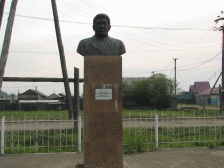

4.Бюст Чусовскому Николаю Николаевичу | Bust of Chusovskoy Nikolay Nikolaevich |
Родился 10 мая 1910 года в селе Александровка в семье охотника. Герой Советского Союза, участник Великой Отечественной войны, командир батальона 172-го гвардейского стрелкового полка 57-й гвардейской стрелковой дивизии 8-й гвардейской армии1-го Белорусского фронта, гвардии майор. Член ВКП(б)/КПСС с 1931 года. Окончил Якутскую национальную военную школу в 1935. Памятник поставлен в честь 60-летия Победы в 2005 году.
| He was born on May 10, 1910 in the village of Aleksandrovka in the family of a hunter. Hero of the Soviet Union, participant of the Great Patriotic War, commander of the battalion of the 172nd Guards Rifle Regiment of the 57th Guards Rifle Division of the 8th Guards Army1st Belorussian Front, his rank was Major. Member of the CPSU(b)/CPSU since 1931. He graduated from the Yakut National Military School in 1935. The monument was erected in honor of the 60th anniversary of the Victory in 2005.
|
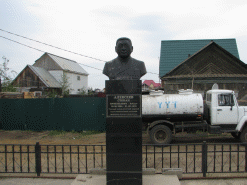

5.Бюст Алексееву Степану Прокопьевичу – Боһуут | Bust of Alekseev Stepan Prokopievich
|
Основатель Нюрбинского района . В течение 9 лет был выборным главой управы, 16 лет улусным главой, 7 лет по совместительству мировым главой образованного по его инициативе Мархинского улуса, ныне Нюрбинского района. Активный меценат строительства школ, церквей и дорог в улусе, один из первых представителей торгового капитала дореволюционной Якутии, купец I, II гильдий. За свою короткую, всего 53 года, жизнь стал обладателем трех золотых, двух серебряных и одной бронзовой медалей Российской империи. Его помощь не ограничивалась родным краем, доходила до Иркутской области и далекой Польши.
| He was a founder of Nyurba district. For 9 years, he was elected head of the council, 16 years as the ulus head, 7 years concurrently as world head of the Markha ulus, now Nyurba district has been formed on his initiative. An active patron of the construction of schools, churches and roads in the ulus, one of the first representatives of the commercial capital of pre-revolutionary Yakutia, merchant had I, II guilds. In his short, only 53 years old, life became the owner of three gold, two silver and one bronze medals of the Russian Empire. His contribution was not limited to his native land, reached the Irkutsk region and distant Poland.
|
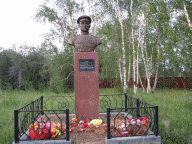

6.Бюст Кудряшову Николаю Петровичу | Bust of Kudryashov Nikolay Petrovich
|
Уроженец Иркутской области, был призван в ряды Красной Армии 1940 году. С июля 1941 года был стрелком, командиром отделения, помощником и командиром взвода, командиром стрелковой роты. Воевал на Западном, Воронежском, Брянском, снова Воронежском, 1-м, 2-м и 4-м Украинских фронтах. Герой Советского Союза с вручением ордена Ленина и медали «Золотая Звезда», кавалер орденов Ленина, Славы III-й степени, медалей, в том числе «За отвагу».
| He was born in Irkutsk region; he was drafted into the ranks of the Red Army in 1940. From July 1941, he was a rifleman, squad leader, assistant and platoon commander, commander of a rifle company. He fought on the Western, Voronezh, Bryansk, again Voronezh, 1 st, 2 nd and 4 th Ukrainian fronts. He became Hero of the Soviet Union with the award of the Order of Lenin and the Gold Star medal, holder of the Orders of Lenin, Glory of the 3rd degree, medals, including “For Bravery”.
|
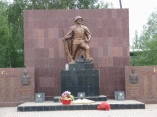

7.Памятник неизвестному солдату(«воину - освободителю») | The unknown soldier monument (cenotaph) |
В XX веке, после окончания кровопролитной Первой мировой войны начала образовываться традиция, по которой нации и государства устанавливают памятники Неизвестному солдату, символизирующие память, благодарность и уважение всем погибшим солдатам, чьи останки так и не были идентифицированы. Открыт 2 сентября в 1966 году. Памятник воинам землякам, погибшим в годы Великой Отечественной Войны. Из нашего района на фронт было призвано 2697 человек. 1152 героически пали на полях сражений. Более 900 человек были награждены боевыми орденами и медалями. 3 человека награждены орденом «Красного знамени», 29 человек орденом «отечественной войны 1, 2 степени», 30 человек «Орденом Славы 3 степени», 27орденом «Красной звезды». Медалями «За боевые заслуги» и «За отвагу» награждены 101 человек. Позднее, в 2001 году, на заднем фоне памятника выстроен из бетона ансамбль из плит с именами участников великой отечественной войны из Нюрбинского улуса.
| In the 20th century, after the end of the bloody First World War, a tradition began to form whereby nations and states erect monuments to the Unknown Soldier, symbolizing memory, gratitude and respect to all the dead soldiers whose remains were not identified. It was opened in September 2 in 1966. Monument to soldier’s countrymen who died during the Great Patriotic War. From our area, 2697 people were called to the front. 1152 heroically fell on the battlefields. More than 900 people were awarded military orders and medals. 3 people were awarded the Order of the Red Banner, 29 people the Order of the Patriotic War 1, 2 degrees, 30 people the Order of Glory 3 degrees, 27 orders of the Red Star. The medals "For Military Merit" and "For Courage" were awarded 101 people. In the background of the monument, an ensemble of slabs with the names of the participants of the Great Patriotic War from the Nyurba ulus was built of concrete later in 2001.
|
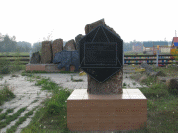


8.Памятник амакинской экспедиции | Monument to the Amakinsk expedition |
7 августа 1949 года на р. Вилюй на песчано-галечной косе "Соколиной" был обнаружен первый якутский алмаз, а к середине сентября на этой косе было найдено уже 22 алмаза. Это событие и стало точкой отсчета - началом великой алмазной эпопеи открытия Якутской алмазоносной провинции. Более 230 работников экспедиции награждены орденами, медалями и другими знаками отличия, 22 человека удостоены звания лауреатов Ленинской и Государственной премий, 35 специалистам присвоено почетное звание "Заслуженный геолог" России и Якутии, 28 геологов награждены престижными в отрасли знаком "Первооткрыватель месторождения".
| The first Yakut diamond was discovered and found on sandy-gravel spit "sokoliny" at the Vilyui River on the 7-th of August 1949 and 22 diamonds had been found on this spit by the middle of September. This event was the starting point and the beginning of the great epic of the Yakut diamond province opening. More than 230 employees of the expedition were awarded orders, medals and other distinctions, 22 people were awarded the title of Lenin and State prizes, 35 specialists were awarded the honorary title of "Honored geologist" of Russia and Yakutia, 28 geologists were awarded the prestigious mark "the first discoverer of the field".
|


9.Памятник Теленкову Илье Дмитриевичу | Ilya Dmitriyevich Telenkov monument |
Главный председатель колхоза, директор совхоза, родился в Октябрьском наслеге, 1941-1947 служил в Красной армии, награжден орденом Октябрьской Революции, орденом трудового красного знамени, орденом Славы третьей степени и многим и другими медалями. Он был награжден четыре раза почетной грамотой ЯАССР С 1962 года стал почетным зоотехником Республики. 1954-1958 гг стал членом обкома КПСС, депутатом Верховного Совета ЯАССР, неоднократно избирался депутатом Нюрбинского района.
| The chief chairman of the collective farm, the director of the state farm, was born in Octobyarski village, in 1941-1947 served in the Red Army, was awarded the Order of the October Revolution, the Order of the Red Banner of Labor, the Glory Order of the third degree and many other medals. He was awarded four times the honorary diploma of the YASSR. Since 1962 he became an honorary livestock specialist of the Republic. 1954-1958 he became a member of the regional committee of the CPSU, a deputy of the Supreme Council of the YASSR, was repeatedly elected a deputy of the Nyurba district.
|
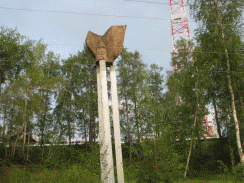

10.Стела комсомольцев | Komsomol stella.
|
Всесоюзный Ленинский коммунистический союз молодежи (ВЛКСМ) — молодежная общественно-политическая организация, созданная на первом Всероссийском съезде союзов рабочей и крестьянской молодежи 29 октября — 4 ноября 1918 года. К 60-летию ВЛКСМ в октябре 1978 года стелу первому секретарю комсомольской организации Михаилу Григорьеву переименовали «В честь комсомольцев 20-х годов». В 1921 году по поручению коммунистической ячейки организовали ячейку союза молодежи. Секретарем был избран Михаил Григорьев, выходец из Сунтарского района, комсомольцев тогда было всего 12-15 человек. Они проделали большую работу по оказанию помощи голодающим Поволжья. Собирали хлеб, масло, яйца и другие продукты, участвовали в ликвидации заговоров купцов.
| The All-Union Leninist Communist Youth Union (Komsomol) is a youth public-political organization established at the first All-Russian Congress of Workers 'and Peasants' Unions from October 29 to November 4, 1918. On the 60th anniversary of the Komsomol in October 1978, the Stella to the first secretary of the Komsomol organization, Mikhail Grigoriev, was renamed “In honor of the 20s Komsomol members”. In 1921, on behalf of the communist cell, they organized a cell of the youth union. Mikhail Grigoriev, a native of the Suntar District, was elected secretary; then there were only 12-15 members of the Komsomol. They did a great job of helping the hungry people of the Volga region. They collected bread, butter, eggs and other products, participated in the elimination of merchant’s conspiracies.
|
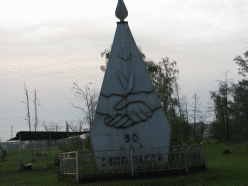

11.Памятник к пятидесятилетию ЯАССР | Fiftieth anniversary of the YASSR Monument |
Якутская Автономная Советская Социалистическая Республика (Якутская АССР, ЯАССР) — автономная республика в составе РСФСР. Существовала в 1922—1992 гг. В 1972 году к 50-летию образования Якутской АССР был установлен обелиск «дружба». Национальная политика коммунистической партии исходила из того, что любая нация и народность, малая или большая, имеет право решать свою судьбу в соответствии с жизненными интересами и желаниями.
| The Yakut Autonomous Soviet Socialist Republic (Yakut ASSR, YASSR) is an autonomous republic within the RSFSR. It was in 1922-1992. In 1972, the "friendship" obelisk was established to the 50th anniversary of the formation of the Yakut ASSR. The national policy of the Communist party was based on the fact that any nation and nation, small or large, has the right to decide its own destiny in accordance with the vital interests and desires.
|
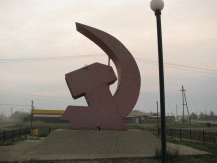

12.Памятник октябрьской революции | October Revolution monument |
Вели́кая Октя́брьская социалисти́ческая револю́ция, одно из крупнейших политических событий XX века, произошедшее в России в октябре (по новому стилю — в ноябре) 1917 года и повлиявшее на дальнейший ход всемирной истории. В результате вооружённого восстания было свергнуто Временное правительство и к власти пришло правительство, сформированное II Всероссийским съездом Советов, абсолютное большинство делегатов которого составили большевики (РСДРП(б)) и их союзники левые эсеры, поддержанные также некоторыми национальными организациями, небольшой частью меньшевиков-интернационалистов, и некоторыми анархистами.
| The Great October Socialist Revolution, one of the major political events of the 20th century, took place in Russia in October (in a new style - in November) in 1917 and influenced the further course of world history. As a result of the armed uprising, the Provisional Government was overthrown and the government formed by the II All-Russian Congress of Soviets came to power, the overwhelming majority of whose delegates were Bolsheviks (RSDLP (b)) and their allies left Socialist-Revolutionaries, also supported by some national organizations and some anarchists.
|
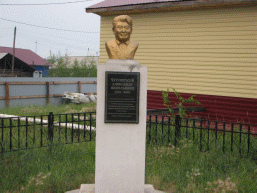

13.Бюст Чусовскому Александру Николаевичу | Chusovskoy Alexander Nikolayevich bust |
Заслуженный учитель школ ЯАССР, заслуженный работник культуры ЯАССР, отличник народного просвещения, награжден орденом Отечественной войны II степени, медалями: « За трудовую доблесть», «За доблестный труд в Великой Отечественной войне1941-1945.гг.»
| Honored teacher of the schools of the Yakut Autonomous Soviet Socialist Republic, Honored Worker of Culture of the YASSR, had degree of excellent public education, awarded the Order of the Patriotic War of the II degree, medals: "For Labor Valor", "For Valiant Labor in the Great Patriotic War1941-1945."
|
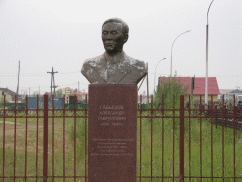

14.Бюст Габышеву Александру Гавриловичу | Bust to Gabyshev Alexander Gavrilovich |
Советский хозяйственный, государственный и политический деятель, В 1919-1939 гг. — уполномоченный Сибревкома по Якутской области, инструктор РКП(б) в Якутске, председатель Вилюйского уездного революционного комитета, слушатель Высших партийных курсов при ЦК ВКП(б), и. о. ответственного секретаря Якутского областного комитета ВКП(б), управляющий делами ЦИК и СНК Якутской АССР, студент МСХА им. Тимирязева, парторг ВКП(б) Верхоянской геологической экспедиции, председатель ЦИК Якутской АССР, преподаватель политической экономии Якутского педагогического института. Избирался депутатом Верховного Совета СССР 1-го созыва. | The Soviet economic, state and political figure, in 1919-1939 — the Commissioner of Sibrevkom in the Yakut region, the instructor of Russian Communist party (Bolshevik) in Yakutsk, the Chairman of the Vilyuisk district revolutionary Committee, the listener of the Highest party courses at the Central Committee of Central Committee of the Communist party of the Soviet Union (Bolshevik), the acting Executive Secretary of the Yakut regional Committee of VKP(b), the Manager of Affairs of the Central executive Committee and The Council of people's Commissars of the Yakut Autonomous Soviet socialist Republic, the student of Moscow Timiryazev Agricultural Academy , party organizer of the VKP (b) Verkhoyansk geological expedition, Chairman of the CEC of the Yakut ASSR, teacher of political economy of the Yakut pedagogical Institute. He was elected as a Deputy of the Supreme Soviet of the USSR of the 1st convocation.
|
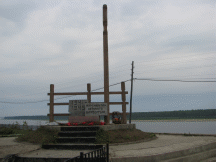

15.Монумент «я отсюда ушел на войну» | Monument" I left here for the war" |
Установлен в 2005 году в канун празднования 60-летия Победы. В годы ВОВ на этом месте собирались и ждали парохода призывники. С места, где стоит монумент призывники на пароходе уплывали в Якутск. Оттуда же пароходе, вернее на барже , которую тянул пароход, отапливаемые дровами, они плыли до станции Осетрово Иркутской области. Оттуда якутяне уходили на фронт на поезде.
| It was established on the eve of the 60th anniversary of the Victory in 2005. During the years of the Second World War, recruits gathered at this place and waited for the steamship. From the place where the monument stands, conscripts on the ship sailed to Yakutsk. From the same steamer, or rather, on a barge pulled by a steamboat heated by firewood, they sailed to the station “Osetrovo” in the Irkutsk region. From there, the Yakut recruits went to the front by train.
|
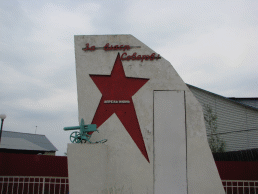

16.Монумент героям обороны Нюрбы | Monument to the heroes of Nyurba defense. |
В связи с 50-летием Октябрьской революции, в 1967 году бюро РК КПСС приняло решение об установлении обелиска участникам обороны Нюрбы в районном центре, мемориальных досок на зданиях, связанных с событиями Октябрьской Революции и гражданской войны. Оборона Нюрбы проходила с 16 по 20 июня 1922 года. Оборону держали 44 бойца (по другим данным 46), среди которых были ребята 16-21 года рождения, против 300 белоповстанцев.
| In connection with the 50th anniversary of the October Revolution, in 1967 the Bureau of the CPSU RK decided to establish an obelisk for Nyurba participants in the district center, memorial plaques on buildings related to the events of the October Revolution and the civil war. The defense of Nyurba took place from June 16 to June 20, 1922. The defense was held by 44 fighters (according to other sources 46), among who were guys aged 16-21 years, against 300 White Army fighters.
|
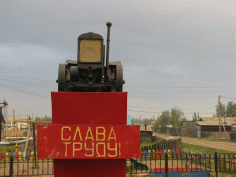

17.Монумент «Трактор ХТ3» | Monument «Tractor» |
Памятник был установлен в 1982 году в честь 50-летия со дня образования Нюрбинской МТС. В Нюрбинском районе первый колесный трактор «Фордзон» появился в 1930 году, а в 1932 году создана машино-тракторная станция (МТС). Одним из первых на тракторе "Фордзон" работали сыновья участника обороны Нюрбы Василия Ивановича Наумова Василий и Александр Наумовы, а Давыдов Иван Петрович уроженец с.Хаты в 1932 году. Был призван в армию и погиб в 1942 году. Одной из первых трактористок женщин является Яковлева Пелагея Семёнова. Она поработала трактористкой с 1939-1951 годы. преподавателем первых курсов трактористов был Каликин Дмитрий Иванович, уроженец Орджоникидзевского района.
| The monument was installed in 1982 in honor of the 50th anniversary of the founding of the Nyurba MTS. In the Nyurbа District, the first Fordson wheeled tractor appeared in 1930, and in 1932 a machine-tractor station (MTS) was created. One of the first on the tractor "fordzon" worked sons of the participant of Nyurba defense Vasily Ivanovich Naumov Vasily and Alexander Naumov, and Davydov Ivan Petrovich the native of S. Hata in 1932. He was drafted into the army and died in 1942. One of the first female tractor drivers is Yakovleva Pelageya Semenovna. She worked as a tractor driver from 1939-1951 as a teacher the first year the tractor was Kalinin Dmitry Ivanovich, born in Ordzhonikidze district.
|


18.Памятник ветеранам тыловикам | Monument to veterans of the rear |
Мы победили в войне благодаря героическим работникам тыла Вся работа Районного Совета Депутатов Трудящихся за время ВОВ протекала в суровой обстановке войны Советского народа против озверелого германского нацизма. Наши задачи в работе вытекали целиком из требований военного времени и обеспечения безусловного выполнения и перевыполнения хозяйственных и производственных программ в районе, укрепить тыл, увеличить нашу помощь доблестной Красной Армии.
| We won the war thanks to the heroic workers of the rear All the work of the District Council of Workers' Deputies during the Great Patriotic War proceeded in the harsh atmosphere of the war of the Soviet people against the brutal German Nazism. Our tasks in the work stemmed entirely from the requirements of wartime and ensuring unconditional implementation and overfulfilment of economic and production programs in the area strengthen the rear, increase our assistance to the valiant Red Army.
|
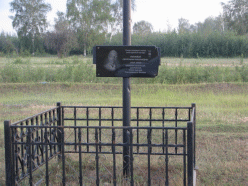

19.Памятник Ивановой Ефросинье Николаевне | Monument of Euphrosynya Ivanova Nikolaevna |
Славится Ефросинья Николаевна, тем, что воспитала и вырастила девятерых выдающихся людей. На открытие улицы приняли участие дети и внуки Ефросиньи Николаевны: Иванов Валентин Капитонович – летчик-инженер, кандидат военных наук, полковник ВВС РФ в отставке, Заслуженный военный специалист РФ, кавалер Ордена «За службу Родине в Вооруженных силах СССР», Почетный гражданин города Нюрбы Корнилов Геннадий Андреевич–пенсионер Центрального аппарата МВД РФ, с 2000 по 2006 гг. – заместитель начальника Следственного Комитета при МВД РФ, генерал-майор юстиции в отставке, генерал-майор налоговой полиции в отставке, Почетный сотрудник МВД РФ, Заслуженный юрист РС (Я), живет в г. Москве. Корнилов Анатолий Андреевич – заместитель директора ГБУ РС (Я) научно-практический центр « Фтизиатрия», руководитель мероприятий « Защита населения от туберкулеза» государственной программы « Развитие здравоохранения РС (Я)», заслуженный работник здравоохранения РФ, обладатель медали « За заслуги перед отечественным здравоохранением», действительный член Академии медико-технических наук, кандидат медицинских наук, торакальный хирург высшей категории, врач-фтизиатр высшей категории, ветеран труда. Иванова Роза Капитоновна – врач-психиатр эксперт высшей квалификационной категории, ветеран труда, награждена медалью «200 лет МВД России», обладатель Знака отличия «Гражданская доблесть», юбилейного знака РС (Я) «380 лет Якутия с Россией», медали «70 лет Победы в Великой отечественной войне», пенсионерка, Алексеева Капиталина Капитоновна–филолог, научно-технический переводчик, ветеран труда, общественный деятель, организатор международного клуба Ротари в городе Якутске, обладатель знака «Гражданская доблесть», лауреат медали Пола Харриса «За укрепление мира и взаимопонимания между народами», автор 3 книг. Гурьева Ольга Юльевна – артистка балета Национального театра танца РС (Я), в настоящее время - менеджер ООО «Энергаз» Корнилова Зинаида Андреевна – геофизик, секретарь Президиума Академии наук РС (Я), ответственный секретарь научного журнала «Наука и образование», обладатель знака «Гражданская доблесть», Почетной Грамоты Правительства РС (Я)
| Efrosinya Nikolaevna is famous for raising nine prominent people. The opening of the street was attended by children and grandchildren of Efrosinya Nikolaevna: Ivanov Valentin Kapitonovich - Pilot-Engineer, Candidate of Military Sciences, retired Colonel of the Air Force of the Russian Federation, Honored Military Specialist of the Russian Federation, holder of the Order "For Service to the Motherland in the Armed Forces of the USSR", Honorary Citizen of the town of Nyurba Kornilov Gennady Andreevich –– pensioner of the Central Office of the Ministry of the Russian Federation Internal Affairs, from 2000 to 2006. - Deputy Head of the Investigative Committee of the Ministry of Internal Affairs of the Russian Federation, Major General of Justice, retired, Major General of the Tax Police Retired, Honorary Officer of the Ministry of Internal Affairs of the Russian Federation, Distinguished Lawyer of the RS (Y), lives in Moscow. Anatoly Andreevich Kornilov - Deputy Director of the State Budgetary Institution of Medicine of the Republic of Sakha (Yakutia) Scientific and Practical Center “Physiology”, Head of Measures “Protecting the population from tuberculosis” of the state program “Health Development of the RS (Y)” public health ”, full member of the Academy of Medical and Technical Sciences, candidate of medical sciences, thoracic surgeon of the highest category, TB specialist of the highest category, labor veteran. Ivanova Roza Kapitonovna - psychiatrist expert of the highest qualification category, labor veteran, was awarded the medal “200 years of the Ministry of Internal Affairs of Russia”, winner of the Insignia “Civil valor”, the anniversary mark of the RS (Y) “380 years of Yakutia with Russia”, medals “70 years Victories in the Great Patriotic War ", pensioner, Alekseeva Kapitalina Kapitonovna – philologist, scientific and technical translator, labor veteran, public figure, organizer of the Rotary International Club in the city of Yakutsk, winner of the “Civil Valor” sign, winner of the Paul Harris medal “For strengthening peace and mutual understanding between nations”, author of 3 books. Olga Yurievna Gureyeva - Ballet Dancer of the National Dance Theater of the RS (Y), at present - Manager of “Energaz” LLC Kornilova Zinaida Andreevna - geophysicist, secretary of the Presidium of the Academy of Sciences of the RS (Y), executive secretary of the scientific journal "Science and Education", holder of the sign "Civil Valor", Honorary Diploma of the Government of the RS (Y)
|


20.Памятник авиаторам Нюрбы | The Nyurba aviators monument
|
В рамках 60-летия Нюрбинского авиапредприятия 28 октября в городе отметили День автомобилиста открытием памятника автомобилю ГАЗ-51. Идея создания памятника принадлежит водителю службы спецавтотранспорта аэропорта «Нюрба» Владимиру Дмитриеву. Заброшенный автомобиль обнаружили в районе нефтебазы, затем началась кропотливая реставрационная работа. Недостающие детали искали не только в Нюрбе, но и в наслегах. Перед покраской весь автомобиль был тщательно зачищен, после нанесены фирменные аэрофлотовские знаки. 28 октября в торжественной обстановке под руководством директора филиала «Аэропорт Нюрба» Степана Сафонова и председателя цехкома профсоюза Марианны Павловой был открыт памятник автомобилисту. Мемориал посвящен водителям служб спецавтотранспорта, без которых не может осуществляться комплексная работа ни одного аэропорта.
| On October 28, in the framework of the 60th anniversary of the Nyurba airline, town celebrated the Day of the Motorist with the opening of a monument to the GAZ-51 lorry. The idea of creating a monument belongs to the driver of the special transport service of the airport “Nyurba” Vladimir Dmitriev. An abandoned lorry was found near the tank farm, and then painstaking restoration work began. Missing details were sought not only in Nyurba, but also in the villages. Before painting, the entire car was thoroughly trimmed, after which branded Aeroflot marks were applied. On October 28, a monument to the motorist was opened in a solemn atmosphere under the direction of the director of the branch “Airport Nyurba” Stepan Safonov and the chairman of the trade union committee of the trade union Marianna Pavlova. The memorial is dedicated to drivers of special road transport services, without which the complex work of a single airport cannot be carried out.
|
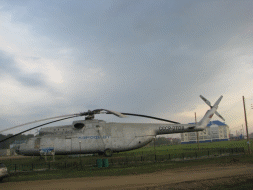

21.Памятник вертолетчикам МИ-6 | Monument to helicopter pilots MI-6 |
История вертолетной авиации Якутии начинается с сентября 1955 года. Эта техника, не нуждающаяся для взлета и посадки в аэродромах, очень нужна была для работы в Якутии с ее бескрайними просторами и плохо развитой сетью наземного транспорта. Поэтому Якутская авиагруппа получила вертолеты одной из первых в стране. Вертолеты Ми-6 поступали на базирование в Якутск и Нюрбу.
| The history of the helicopter aviation of Yakutia begins in September 1955. This technique, which does not need to take off and land at aerodromes, was very necessary for work in Yakutia with its endless spaces and a poorly developed network of land transport. Therefore, the Yakut Air Group received one of the first helicopters in the country. Mi-4 helicopters arrived at the base in Yakutsk and Nyurba.
|
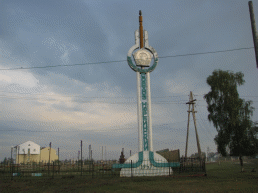

22.Памятник Нюрбинскому совхозу | Monument to Nyurba farmers |
Первый совхоз был основан на территории села Антоновка в Нюрбинском районе 1957. Одним из этапов хозяйственного освоения является создание в 1957 г. совхоза «Нюрбинский», который имел 44769 га земли, 14623 га сенокоса, 12769 га пастбищ, 3750 га пашен, крупного рогатого скота – 6535 голов, в том числе 2431 корова, 3622 голов лошадей. С начала 1963 г. началась кампания укрупнения районов Якутской АССР, район развивался по плановой экономике страны, были трудовые достижения. Хозяйство Нюрбинского района постепенно стало подниматься, отмечены трудовые достижения предприятий и хозяйств. Так, в 1964 г. прославился Нюрбинский промкомбинат, который выполнил годовой план продукции на 110,8 %.
| The first state farm was founded on the territory of the village of Antonovka in the Nyurba district of 1957. One of the stages of economic assistance was the creation in 1957 of the Nyurba state farm, which had 44,769 hectares of land, 14,623 hectares of haymaking, 12,769 hectares of pastures, 3,750 hectares of arable land, cattle - 6535 heads, including 2431 cows, 3622 heads of horses. From the beginning of 1963, a campaign began to consolidate the districts of the Yakut Autonomous Soviet Socialist Republic, the region developed according to the planned economy of the country, there were labor achievements. The economy of the Nyurba district gradually began to raise, the labor achievements of enterprises and farms were marked. So, in 1964, the Nyurba industrial complex became famous, which fulfilled the annual production plan by 110.8%.
|


23.Cквер имени первого тракториста наслега Афанасию Семеновичу Яковлеву –Табаарыс | Square after Afanasiy Semenovich Yakovlev |
Была организована Механизированная тракторная станция, ставшая впоследствии флагманом сельскохозяйственной индустрии улуса, за короткий период обустроена база станции. Парк сельскохозяйственной техники пополнялся невиданными до этого машинами. Первые трактористы приступили к подъему новых пахотных земель и обмолоту нового урожая. В числе первых трактористов относится Афанасий Семенович Яковлев –Табаарыс, до сих пор люди помнят его заслуги.
| The Mechanized Tractor Station was organized, which later became the flagship of the agricultural industry of the ulus, and in a short period the base of the station was equipped. The park of agricultural machinery was replenished with machines never seen before. The first tractor drivers began to raise new arable land and thresh a new crop. Among the first tractor drivers was Afanasy Semenovich Yakovlev –"Tabaaris", people still remembered his merits.
|
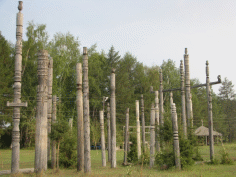

24.Юбилейные коновязи | Anniversary totem poles |
Сэргэ — ритуальный столб, коновязь. Изначально сэргэ ставились у жилья (юрты, балагана) якутов и использовали по их прямому назначению – для привязывания коня. Сэргэ означало, что у земли есть хозяин. В первую очередь, сэргэ связано с культом коня. Сэргэ для нас — это символ счастья и благополучия. Сэргэ устанавливали и устанавливают во время национального праздника «Ыhыах» (Ысыах), юбилеев, праздников и значимых мероприятий.
| "Serge" - totem pole. Initially, the totem pole were set up at the dwelling (yurt, a winter house) of the Yakuts and used for their intended purpose - to tie a horse. Totem pole meant that the land has a master. First of all, totem pole is associated with the cult of the horse. For us, it is a symbol of happiness and well-being. It was installed and set during the national holiday "Yhyakh" (Ysyakh), anniversaries, holidays and significant events.
|
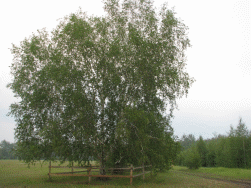

25.Достопримечательности «три березы» | Sight "three birches” |
Ветеран педагогического труда Мартынов Н. Н огородил березу за уникальность, так как символом города является береза. В обрядах жизненного цикла у якутов, сакральные деревья отражали универсальные символы, характерные для всего ареала изучаемых народов. Береза это символ плодородия. | A veteran of pedagogical work, N. N. Martynov, fenced a birch for uniqueness, as the symbol of our town is birch. In the rituals of the life cycle of the Yakuts, sacred trees reflected universal symbols characteristic of the entire range of the studied peoples. A birch is a symbol of fertility.
|
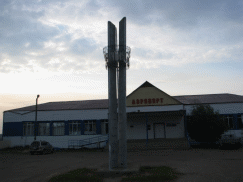

26.Cтела «350 лет Россия – Якутия» | Stella of " 350 years Russia-Yakutia”
|
Историческое значение вхождения Якутии в состав Российского государства трудно переоценить. Весь ход истории Якутии в составе России представляет собой развитие нашей республики по пути цивилизации и прогресса, взаимопомощи и созидания. Была ликвидирована многовековая изолированность народов края, а совместная деятельность стала устойчивым фактором социально-экономического развития региона. В свою очередь, Россия приобрела территорию с богатейшими природными ресурсами, освоение и использование которых было призвано укрепить финансовое положение страны. Якутия стала форпостом дальнейшего продвижения русских первопроходцев на Дальний Восток.
| The historical significance of the entry of Yakutia into the Russian state is difficult to overestimate. The whole course of the history of Yakutia as part of Russia is the development of our republic along the path of civilization and progress, mutual aid and creation. The centuries-old isolation of the peoples of the region was eliminated, and joint activities became a stable factor in the socio-economic development of the region. In turn, Russia acquired a territory with the richest natural resources, the development and use of which was intended to strengthen the financial position of the country. Yakutia became an outpost for the further advancement of Russian pioneers in the Far East.
|
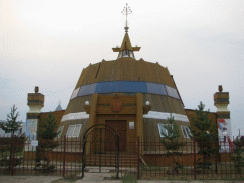

27.Достопримечательность «Дом Олонхо» | The "House of Olonkho” |
«Дом Олонхо» – трёхъярусное купольное здание, архитектурным прототипом которого является якутская ураса. Конусная композиция высотой 30 метров ориентирована на все стороны света, является доминантной и достопримечательностью «Земли Олонхо». Архитектура «Дома Олонхо» соответствует суровым природным условиям Севера, где царит вечная мерзлота, и формам традиционных построек якутов, которым характерны наклонные стены зимнего балагана и единое пространство летнего жилища – урасы. Входная группа расположена по оси восток – запад, куда ведёт бульвар вдоль запроектированных водных каскадов и фонтанов. Главный вход организован со стороны улицы Степана Васильева, с противоположной стороны организован выход на восток в ритуальную зону «Встреча солнца». Пространство «Дома Олонхо» по якутской мифологии разделено на три уровня, олицетворяющих три части мира: «Нижний мир», «Средний мир» и «Верхний мир».
| “Olonkho House” is a three-tier dome building, the architectural prototype of which is the Yakut house. The conical composition with a height of 30 meters is oriented to all sides of the world, is the dominant and landmark of the Land of Olonkho. The architecture of the Olonkho House corresponds to the harsh natural conditions of the North, where permafrost reigns, and to the forms of Yakut traditional buildings, which are characterized by sloping walls of a winter shed and a single space of a summer dwelling - uras. The entrance group is located along the east-west axis, where the boulevard leads along the projected water cascades and fountains. The main entrance is organized from the side of Stepan Vasiliev street, from the opposite side there is an exit to the east to the ritual zone “Meeting of the Sun”. The space of the “House of Olonkho” according to Yakut mythology is divided into three levels, personifying three parts of the world: “Lower World”, “Middle World” and “Upper World”.
|
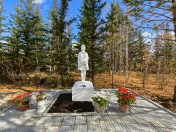

28.Памятник пионерии | Pioneer monument |
Всесоюзная пионерская организация имени В.И.Ленина родилась на заре Советской власти. 19 мая 1922 года день рождения пионерской организации. Имя Владимира Ильича Ленина пионерской организации было присвоено в январе 1924 года. В годы Великой Отечественной войны проявились лучшие черты юных ленинцев. Они были мужественными и стойкими, боролись и трудились как взрослые, презирали смерть как взрослые. Десятки пионеров за подвиги в годы войны получили награды Родины. В летопись пионерской организации золотыми буквами написаны имена Вали Котика, Лёни Голикова, Зины Портновой и Марата Казея, которым посмертно присвоено звание Героя Советского Союза. Памятник установлен в 1968 году.
| Pioneer Union Organization named after V. I. Lenin was born at the dawn of Soviet power. May 19, 1922 is the birthday of the pioneer organization. The name of Vladimir Ilyich Lenin of the pioneer organization was assigned in January 1924. During the Great Patriotic War, the best features of the young Leninists showed up. They were courageous and steadfast, fought and worked as adults, despised death as adults. Dozens of pioneers for their deeds during the war years received awards from the Motherland. In the chronicle of the pioneer organization, the names of Vali Kotik, Leni Golikova, Zina Portnova and Marat Kazei are written in gold letters, who were posthumously awarded the title Hero of the Soviet Union. The monument was established in 1968.
|
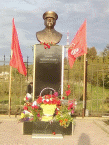

29. Памятник-бюст Иосифу Виссарионовичу Сталину | Monument-bust to Joseph Vissarionovich Stalin |
Ио́сиф Виссарио́нович Ста́лин (настоящая фамилия Джугашви́ли) 6 декабря 1878 (по официальной версии — 9 декабря 1879), Гори, Тифлисская губерния, Российская империя — советский политический, государственный, военный и партийный деятель, российский революционер. Фактический руководитель СССР. Генеральный секретарь ЦК КПСС (1922—1953). Маршал Советского Союза (1943) , Генералиссимус Советского Союза (1945). Народный комиссар обороны СССР (с 19 июля 1941 года), Председатель Совнаркома СССР и Председатель Государственного комитета обороны СССР. Благодаря ему СССР победил в Великой Отечественной войне, в стране механизировалось сельское хозяйство, Союз превратился в ядерную сверхдержаву, имеющую геополитическое влияние во всем мире. Памятник был установлен по инициативе нюрбинского отделения КПРФ на спонсорские деньги.
| Joseph Vissarionovich Stalin (real name Dzhugashvili) December 6, 1878 (according to the official version - December 9, 1879), Gori, Tiflis province, Russian Empire - Soviet political, statesman, military and party leader, Russian revolutionary. Actual leader of the USSR. General Secretary of the Central Committee of the CPSU (1922-1953). Marshal of the Soviet Union (1943), Generalissimo of the Soviet Union (1945). People's Commissar of Defense of the USSR (since July 19, 1941), Chairman of the Council of People's Commissars of the USSR and Chairman of the USSR State Defense Committee. Thanks to him, the USSR won the Great Patriotic War; agriculture was mechanized in the country, the Union turned into a nuclear superpower with geopolitical influence throughout the world. The monument was erected at the initiative of the Nyurba branch of the Communist Party of the Russian Federation with sponsorship money.
|


30.Памятник макет Т-34
| Monument of dummy tank T-34 |
За отчетный период трудящиеся нюрбинского района воодушевленные приказами Верховного Главнокомандующего товарища Сталина и героической наступлением Красной Армии еще усилили помощь фронту. Они своими трудовыми сбережениями, ежемесячными отчислениями из зарплаты, цветными и черными металлами, ценными вещами, облигациями активно помогали созданию мощного фонда обороны, организованно послали в подарок действующей армии теплые вещи, отправляли коллективные и индивидуальные посылки во время ВОВ. На строительство танковой колонны было собрано 87988 руб. 30812 руб. 118800 руб.
| During the reporting period, the working people of the Nyurba region, inspired by the orders of the Supreme Commander-in-Chief Comrade Stalin and the heroic offensive of the Red Army, further increased their assistance to the front. With their labor savings, monthly deductions from salaries, non-ferrous and ferrous metals, valuables, bonds, they actively helped to create a powerful defense fund, organized warm clothes as a gift to the army, and sent collective and individual parcels during the Second World War 87,988 rubles were collected for the construction of a tank column. 30812 rub. 118800 rub.
|
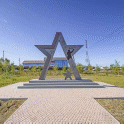

31.Памятник Донскому Ф.С.
| Monument to Donskoy F.S.
|
«За годы войны на защиту Отечества было призвано более 62 тысяч якутян. Воины из Якутии служили во всех родах войск, показывая дисциплинированность, самоотверженность и мужество. Они прославились как отличные снайперы, умелые разведчики, отважные артиллеристы, танкисты, летчики. Среди них был ефрейтор Феодосий Семенович Донской, призванный Нюрбинским районным военкоматом Якутской АССР» Памятник в виде стилизованной звезды, на одном луче звезды - силуэт солдата и надпись "Были, и мы из Якутии… Донской". Феодосий Семенович Донской, участник Великой Отечественной войны, кавалер ордена Отечественной войны II степени, ордена Дружбы народов, заслуженный работник народного хозяйства РС (Я), Почетный гражданин РС (Я), Нюрбинского и Эвено-Бытантайского районов, журналист, основатель телевещания республики, кандидат экономических наук. В 1945 г. расписался на стенах рейхстага “Были, и мы из Якутии Донской, из Чувашии Коннов".
| “During the war years, more than 62,000 Yakutians were called up to defend the Fatherland. Warriors from Yakutia served in all branches of the military, showing discipline, dedication and courage. They became famous as excellent snipers, skillful scouts, brave gunners, tankers, and pilots. Among them was corporal Theodosius Semenovich Donskoy, called up by the Nyurba district military registration and enlistment office of the Yakut Autonomous Soviet Socialist Republic " A monument in the form of a stylized star, on one ray of the star there is a silhouette of a soldier and the inscription "We were, and we are from Yakutia ... Donskoy." Feodosy Semenovich Donskoy, participant in the Great Patriotic War, holder of the Order of the Patriotic War II degree, Order of Friendship of Peoples, Honored Worker of the National Economy of the RS (Y), Honorary Citizen of the RS (Y), Nyurba and Eveno-Bytantay districts, journalist, founder of the television broadcasting of the republic, candidate economic sciences. In 1945, he signed on the walls of the Reichstag “We were, and we are from Yakutia Donskoy, from Chuvashia Konnov.” |
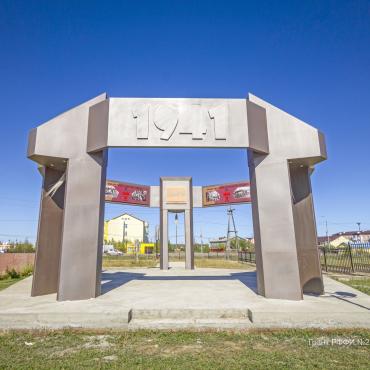
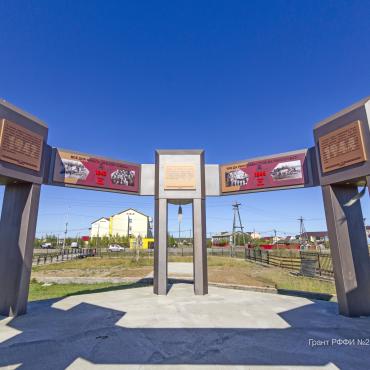

32. Памятник Колизей, посвященный труженикам тыла.
| Monument Colosseum, dedicated to home front workers. |
Монумент представляет собой 10 четырехгранных столбов, установленных вкруг. В верхней части столбов установлены плиты с годами войны, на внутренней стороне плит имеются информационные таблички с фотографиями и информацией о работниках тыла. Символизирует увековечение истории тыла, посвящён колхозникам, ковавшим Победу в тылу.
| The monument consists of 10 tetrahedral pillars set around. At the top of the pillars there are plates with the years of the war, on the inside of the plates there are information plates with photographs and information about the rear workers. It symbolizes the perpetuation of the history of the rear, dedicated to the collective farmers who forged the Victory in the rear.
|


33. Романова Мария Егоровна (сэбиэт Мааса) (13.07.1911-29.09.1993) | Romanova Maria Egorovna (Sebiet Maas) (13.07.1911-29.09.1993) |
Председатель исполкома сельсовета II Нюрбы и Октябрьского наслега (1945-1961 годы), депутат Верховного Совета ЯАССР III созыва, депутат райсовета 5 созывов, награждена медалями СССР, «Медалью материнства» II степени, тремя Почетными грамотами Президиума Верховного Совета Якутской АССР. Занесена в Книгу Почета Нюрбинского района и Октябрьского наслега. Стояла у истоков создания совхоза «Нюрбинский». Именем Романовой М.Е. названа улица в селе Антоновка. | Chairman of the executive committee of the village council of the II Nyurba and Oktyabrsk settlement (1945-1961), deputy of the Supreme Council of the Yakut Autonomous Soviet Socialist Republic of the III convocation, deputy of the district council of 5 convocations, was awarded medals of the USSR, the “Medal of Motherhood” II degree, three Honorary Diplomas of the Presidium of the Supreme Council of the Yakut Autonomous Soviet Socialist Republic. She was listed in the Book of Honor of the Nyurba district and the Oktyabrsk settlement. She stood at the origins of the creation of the Nyurba state farm. A Street is named in the name of Romanova M.E. in Antonovka village.
|
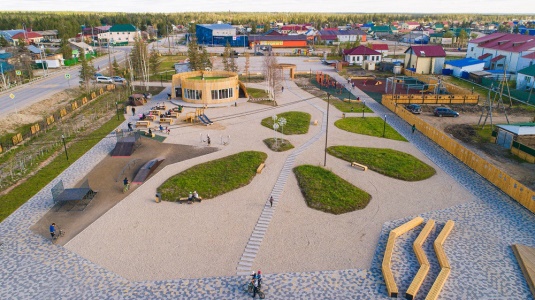


| 34. Парк имени Сергея Васильева | Park after Stepan Vasiliev |
Возрожденный парк является первым этапом комплексного проекта сети общественных пространств «Семь километров». Парк после благоустройства стал местом не только для повседневного посещения и отдыха горожан, но и местом событийным, в котором проходят основные городские мероприятия - День города, городской Ысыах, проводы зимы, Новый год. Парк расположен в активной части города вдоль центральной улицы Степана Васильева. Через территорию пролегает множество пешеходных маршрутов, активность которых после реализации проекта выросла в разы. В настоящее время на территории парка функционирует круглогодичное кафе, открыты пункты прокатов велосипедов, самокатов, спортивного инвентаря, прогулочных устройств и колясок. Работают предприниматели с мобильными развлекательными аттракционами. Парк, несомненно, важное место, наполненное особой энергетикой, неразрывно связанное с общей судьбой всех нюрбинцев. Воркшопы, обсуждения, встречи, субботники стали поводом для объединения нюрбинцев под эгидой возрождения парка, демонстрируя большой патриотизм и сплоченность горожан. | The rebuilt park is the first stage of a comprehensive project for the “Seven Kilometers” network of public spaces. After the improvement, the park became a place not only for everyday visits and recreation for citizens, but also an event place where the main city events take place - City Day, city Ysyakh, farewell to winter, New Year. The park is located in the active part of the city along the central Stepan Vasiliev Street. There are many pedestrian routes running through the territory, the activity of which has increased significantly since the implementation of the project. Currently, a year-round cafe operates on the territory of the park, and rental points for bicycles, scooters, sports equipment, walking devices and strollers are open. Entrepreneurs work with mobile entertainment attractions. The park is undoubtedly an important place, filled with special energy, inextricably linked with the common fate of all Nyurba residents. Workshops, discussions, meetings, cleanup days became the occasion for the unification of Nyurba residents under the auspices of the revival of the park, demonstrating great patriotism and unity of the townspeople. |
Перспективные памятники города Нюрба.
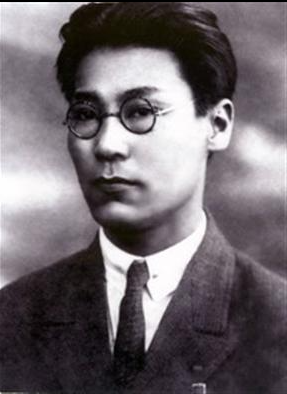

35. Семён Семёнович Сюльский (Сюльскай, Алексеев) (1908—1952) | Semyon Semyonovich Syulsky (Alexeev)
|
Советский партийный и государственный деятель. Родился в 1908 году в Сюльском наслеге Нюрбинского улуса Якутской области. В 1925 году вступил в комсомол. В 1928 году работал председателем Вилюйского окружного бюро юных пионеров и одновременно преподавал в школе. В этом же году вступил в ВКП(б)/КПСС. В 1933 году, после окончания историко-философского отделения Ленинградского педагогического института имени А. И. Герцена (ныне Российский государственный педагогический университет имени А. И. Герцена), Семён Сюльский был назначен директором Якутского педагогического рабфака, затем некоторое время работал на руководящей партийной работе в Якутском областном комитете ВКП(б). С 1936 по 1938 год работал заведующим учебной частью, затем — директором Якутского педагогического техникума и позже — заместителем исполняющего обязанности народного комиссара просвещения Якутской АССР. С 1941 по 1944 год он работал начальником управления по делам искусств при Совете Народных Комиссаров Якутской АССР, затем учился в Москве в Высшей партийной школе при ЦК ВКП(б). С 1946 по 1950 год являлся министром просвещения Якутской АССР. В 1950 году С. С. Сюльский перешёл на работу в Якутский государственный пединститут (ныне Северо-Восточный федеральный университет имени М. К. Аммосова), где работал старшим преподавателем на кафедре педагогики. Одновременно работал в областной партийной школе и вечернем университете марксизма-ленинизма. Избирался депутатом Верховного Совета Якутской АССР, был награждён орденом «Знак Почета» и медалью «За доблестный труд в Великой Отечественной войне 1941—1945 гг.» Был убит в Якутске в 1952 году. Убийцы найдены не были. Инна Феоктистова в своей книге «Нам не дано предугадать» писала:[1] «Семен Сюльский был ярким политиком, неординарной личностью и очень известным человеком. Педагог, нарком просвещения, министр образования ЯАССР Семен Сюльский сыграл заметную роль в развитии образования и культуры родной республики. Его жизнь — часть истории якутского народа. Убит в мае 1952 года — в возрасте 44 лет. Мотивы и истинные убийцы не были установлены. Уголовное дело осталось не раскрытым».
| Semyon Semyonovich Syulsky (Syulsky, Alexeev) (1908-1952). He was a soviet party statesman. He was born in the Syule nasleg of the Nyurba ulus of the Yakut region in 1908. He joined the Komsomol in 1925. He worked as chairman of the Vilyui District Bureau of Young Pioneers and at the same time taught at a school in 1928. In the same year he joined the All-Union Communist Party (Bolsheviks) of Soviet Union. In 1933, after graduating from the historical and philosophical department of the Leningrad Pedagogical Institute named after A. I. Herzen (now the Russian State Pedagogical University named after A. I. Herzen), Semyon Syulsky was appointed director of the Yakut Pedagogical Workers' Faculty, then worked for some time in leading party work in the Yakutsk regional committee of the All-Union Communist Party (Bolsheviks) of Soviet Union. From 1936 to 1938 he worked as the head of the educational department, then as the director of the Yakutsk Pedagogical College and later as the Deputy Acting People's Commissar of Education of the Yakut Autonomous Soviet Socialist Republic. From 1941 to 1944, he worked as the head of the department for arts under the Council of People's Commissars of the Yakut Autonomous Soviet Socialist Republic, then studied in Moscow at the Higher Party School under the Central Committee of the All-Union Communist Party of Bolsheviks. From 1946 to 1950 he was the Minister of Education of the Yakut Autonomous Soviet Socialist Republic. In 1950, S. S. Syulsky went to work at the Yakutsk State Pedagogical Institute (now the North-Eastern Federal University named after M. K. Ammosov), where he worked as a senior lecturer at the Department of Pedagogy. At the same time he worked at the regional party school and the evening university of Marxism-Leninism. He was elected a deputy of the Supreme Council of the Yakut Autonomous Soviet Socialist Republic, was awarded the Order of the Badge of Honor and the medal "For Valiant Labor in the Great Patriotic War of 1941-1945." He was killed in Yakutsk in 1952. The killers were not found. Inna Feoktistova in her book “We Cannot Predict” wrote:[1] “Semyon Syulsky was a bright politician, an extraordinary personality and a very famous person. The teacher, People's Commissar of Education, Minister of Education of the YASSR Semyon Syulsky played a significant role in the development of education and culture of his native republic. His life is part of the history of the Yakut people. Killed in May 1952 - at the age of 44. The motives and true killers have not been established. The case remains unsolved." |
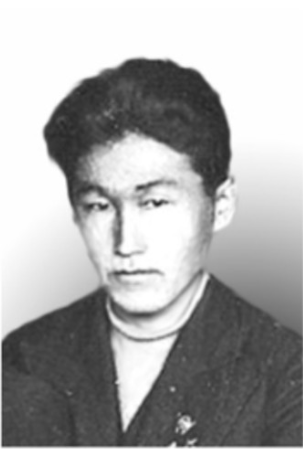

36. Софронов Алексей Афанасьевич (1921-1944 гг.) | Sofronov Alexey Afanasyevich (1921-1944 гг.) |
Софронов Алексей Афанасьевич-якутский поэт-воин, мл. лейтенант, командир взвода, 712 Стрелковый Полк, 132 Стрелковая Дивизия, 1921 года рождения, уроженец села Егольжа Нюрбинского района, якут, член Всесоюзный ленинский коммунистический союз молодёжи, призван Нюрбинским районным военным комиссариатом, погиб 04.07.44 г., захоронен в д. Мыслин Ковельского района Волынской области, Украина. Алексей Афанасьевич Софронов родился в 1921 году в Бестяхском наслеге. Отец, Иванов Афанасий Иванович, житель поселения Джикимдэ, известен прозвищем «Айанньыт» (путешественник), сын Алексеева Ивана Алексеевича. Мать Варвара-жительница поселении Тэнкэ Егольжинского наслега, дочь Софроновых. Одна из девушек семьи Софроновых Александра вышла замуж за Моргусова Александра Игнатьевича из Таркаинского наслега. Мать Алеши умерла после родов. Бабушка Мария Павловна только что рожденного внука унесла жарким летом в поселении Тэнкэ. Алешу воспитывали его дед и бабушка. Поэтому ему присвоили фамилию Софронов. Жители поселения очень любили его за искренность и веселый нрав. После успешного окончания семилетней Егольжинской школы продолжил учебу в районной школе. Он был одним из первых выпускников Нюрбинской средней школы. 20 июня 1941 года был выпускной вечер в честь окончания школы. Алеша не попал в первую волну призыва на войну. Он работал учителем один год в Егольжинской школе. Он был призван на фронт в августе 1942 года. После обучения в военном училище стал офицером минометного расчета. Воевал на фронте командиром взвода. Солдаты уважали его за его справедливое отношение к солдатам. Об этом писали однополчане в своих воспоминаниях.4 июня 1944 года в деревне возле города Ковель на Украине пал смертью храбрых в ночном бою. Об этом написала в своих воспоминаниях основатель и руководитель музея НСОШ №1 А.Г.Николаева “ А.И.Потапов из Якутска, один из первых выпускников, приглашенных на наш выпускной вечер, подарил статью, рукопись из газеты «Кыым» 1944 года. Там было написано «Нас было трое якутов с младшим лейтенантом Алексеем Софроновым, мы воевали вместе. Алексей со своим взводом яростно отразил три раза атаку вражеской роты, под прикрытием 3 самоходных артиллерийских установок, (имевшей10 танков), 3 танка были сожжены, Алексей сам получил тяжелое ранение, погиб, отстреливаясь, смертью храбрых». Внизу письма были подписи трех человек, из которых остались только два: Мигалкин, Сивцев». Алексей Софронов был награжден орденом Великой Отечественной Войны второй степени. В детстве имел обыкновение писать стихи. Стихотворения Алексея и его одноклассника Потапова Алексея часто печатались в школьной газете. Его псевдонимом был Сындыский, а псевдонимом друга Потапова был Чопчулахов Алексей. С детства был разговорчивым, а также выделялся красноречием. Всего этого научился у бабушки Марии Павловны. Если бы не пал на поле брани, он был бы известным поэтом Нюрбинского района. Он оставил после себя шесть стихотворений. В моем детстве мой отец, местные люди превратили стихи «Расставание» в песню и пели за работой. Вот поэтому с детства я знала это стихотворение наизусть. Алексей Софронов прожил на этой земле только 23 года за два дня до смерти он товарищу, Айкарову, как будто зная свою судьбу, написал: «Не бывает войны без жертв. Жизнь так прекрасна. Никто не хочет умирать. Если жизнь прекрасна, так как мы защищаем ее во имя, счастья будущего поколения, смерть должна быть такой же прекрасной. Не гоже кланяться перед врагом, лучше умереть смертью храбрых, сражаясь». | Sofronov Aleksey Afanasyevich - Sakha poet-warrior, ensign, platoon commander, 712th Rifle Regiment, 132nd Rifle Division, born in 1921, native of the village of Egolzha, Nyurba region, Yakut, member of the All-Union Leninist Communist Youth Union, drafted by the Nyurba District Military Commissariat, died on 07/04/44, buried in the village of Myslin Kovelsky district of the Volyn region, Ukraine. Aleksey Afanasyevich Sofronov was born in 1921 in the Bestyakh settlement. Father, Ivanov Afanasy Ivanovich, a resident of the settlement of Dzhikimde, is known by the nickname "Ayannyit" (traveler), the son of Alekseev Ivan Alekseevich. Mother Varvara, a resident of the settlement of Tenke Egolja settlement, daughter of the Sofronovs. One of the girls of the Sofronov family, Alexandra, married Alexander Ignatievich Morgusov from the Tarkain settlement. Alyosha's mother died after giving birth. Grandmother Maria Pavlovna carried away her newly born grandson in the hot summer in the Tenke settlement. Alyosha was raised by his grandfather and grandmother. Therefore, he was given the surname Sofronov. The inhabitants of the settlement loved him very much for his sincerity and cheerful disposition. After successfully graduating from the seven-year Egolja School, he continued his studies at the district school. He was one of the first graduates of the Nyurba secondary school. June 20, 1941 was a graduation party in honor of the end of the school. Alyosha did not get into the first wave of conscription for war. He worked as a teacher for one year at the Egolja School. He was called to the front in August 1942. After studying at a military school, he became an officer in the mortar crew. He fought at the front as a platoon leader. The soldiers respected him for his fair treatment of the soldiers. Fellow soldiers wrote about this in their memoirs. On June 4, 1944, in a village near the city of Kovel in Ukraine, he died a heroic death in a night battle. A.G. Nikolaeva, the founder and head of the museum of the Nyurba secondary school No. 1, wrote about this in her memoirs. It was written there: “We were three Sakha with junior lieutenant Alexei Sofronov, we fought together. Aleksey and his platoon violently repulsed three times the attack of an enemy company, under the cover of 3self-propelled artillery mounts (having 10 tanks), 3 tanks were burned, and Aleksey himself was seriously wounded, died, firing back, the death of the brave. At the bottom of the letter were the signatures of three people, of which only two remained: Migalkin, Sivtsev. Alexei Sofronov was awarded the Order of the Great Patriotic War of the second degree. As a child, he used to write poetry. The poems of Alexei and his classmate Potapov Alexey were often published in the school newspaper. His pseudonym was Syndysky, and the pseudonym of Potapov's friend was Aleksey Chopchulakhov. From childhood he was talkative, and also stood out for his eloquence. I learned all this from my grandmother Maria Pavlovna. If he had not fallen on the battlefield, he would have been a famous poet of the Nyurba region. He left behind six poems. In my childhood, my father, local people turned the verses "Parting" into a song and sang at work. That is why I knew this poem by heart since childhood. Aleksey Sofronov lived on this land for only 23 years, two days before his death, he wrote to his comrade, Aikarov, as if knowing his fate: “There is no war without victims. Life is so wonderful nobody wants to die. If life is beautiful, as we protect it in the name of the happiness of the future generation, death should be just as beautiful. It is not good to bow before the enemy, it is better to die the death of the brave, fighting.
|


37.Ньырбакаан. | Nyirbakan
|
По легенде улус получил своё название от имени Ньырбакан, женщины, которая считается родоначальницей вилюйских якутов. Однажды во время межплеменных столкновений, соплеменники Ньырбакан, спасаясь от преследователей, укрылись в долине Туймаада, найдя приют у Мунньан Дархана — отца исторически известного Тыгына. Ньырбакан вышла замуж за Мунньан Дархана и родила трёх сыновей: Ырыа Быркынаа, Тойук Булгудах и Босхон Бэлгэтии. После смерти Мунньан Дархана, не смирившись с притеснениями воинственного Тыгына — старшего сына Мунньана, Ньырбакаан с сыновьями возвратилась в свои родные края — на Вилюй. Братья обосновали древние роды Хочинского, Сунтарского и Мархинского улусов. В честь Ньырбакаан назван город Нюрба. Нюрба расположена на левом берегу реки Вилюя, в 812 км от Якутска.
| According to legend, the ulus got its name from the name of Nyirbakan, a woman who is considered the ancestor of the Vilyuy Sakha (Yakuts). Once, during intertribal clashes, the Nyirbakan tribesmen, fleeing their pursuers, took refuge in the Tuymaada valley, finding shelter with Munnan Darkhan, the father of the historically famous Tigyn. Nyirbakan married Munnan Darkhan and gave birth to three sons: Yrya Byrkynaa, Toyuk Bulgudakh and Boskhon Belgetii. After the death of Munnan Darkhan, not accepting the oppression of the warlike Tigyn, the eldest son of Munnian, Nyirbakaan and her sons returned to their native land - to Vilyuy. The brothers substantiated the ancient families of Khochin, Suntar and Markha uluses. Nyurba town is named after Nyirbakaan. Nyurba is located on the left bank of the Vilyuу River, 812 km from Yakutsk.
|


38.Никифор Семенов (1962—2000 гг.) | Nikifor Semenov
|
Яркий представитель якутского рока. 1962 г.-родился в селе Мальжегар Нюрбинского района. 2000г.-умер в г.Якутске. Искрометный, многогранный талант певца Никифора Семенова подобно стремительному метеору озарил горизонты якутской эстрады, вызвав у многочисленных поклонников радость и удивление, как при постижении необычайного, светлого явления природы.
| He was a prominent representative of Yakut rock music. 1962 – He was born in the village of Malzhegar, Nyurba district. 2000 -He died in Yakutsk. The sparkling, multifaceted talent of singer Nikifor Semenov, like a swift meteor, illuminated the horizons of the Yakut stage, causing joy and surprise among numerous fans, as if comprehending an extraordinary, bright natural phenomenon. The songs performed and composed by Nikifor Semyonov amaze with their subtle lyricism and at the same time philosophical depth. A singer of God's grace, with his creativity he seemed to fulfill a destiny from above, advocating for the high spirituality of the people. His songs push the listener to think. Nikifor Semenov is the author of songs that now make up the repertoire of many popular groups and performers. With his participation, the groups “Aital” and “Cholbon” became widely known. He was a participant in the Jurmala-89 festival and the winner of the Grand Prix of the Yakutsk-90 competition. During the heyday of Yakut ethno-rock, as a member of the legendary group “Cholbon”, he participated in competitions and festivals throughout the former Soviet Union. The most rated programs on central television of those years were talking about him: “Vzglyad” and “Program “A”. In 2000, at the “Etigen Khomus” competition organized by Radio Victoria, his song “My first love” won in the “Best Song of the Year” category.
|
Content
1.Monument of Lenin…………………………………………………………….2
2.Monument of Stepan Vasiliev…………………………………………………3
3.Bust of A.Y.Ovchinnikova……………………………………………………..4
4.Bust of N.N.Chusovskoy……………………………………………………….6
5.Bust of S.P.Alekseev……………………………………………………............7
6.Bust of N.P.Kudryashov………………………………………………………..8
7.Monument to the unknown soldier…………………………………………….9
8.Monument to Amakinsk expedition……………………………………..........10
9.Monument of I.D.Telenkov…………………………………………………....11
10.Stele of Komsomol…………………………………………………………….12
11.Monument to the Fiftieth anniversary of the YASSR…………………………13
12.Monument to the October Revolution………………………………………....14
13.Bust of A.N.Chusovskoy………………………………………………………15
14.Bust of A.G.Gabyshev………………………………………………………...16
15.Monument to “I left here for the war”……………………………………… .. 17
16.Monument to the heroes of Nyurba defense………………………………...... 18
17.Monument to “Tractor”……………………………………………………... ..19
18.Monument to veterans of the rear…………………………………………......20
19.Monument of E.N.Ivanova…………………………………………………....21
20.Monument to the aviators of Nyurba………………………………….......... ..23
21.Monument of Mi-6…………………………………………………………….24
22.Monument to Nyurba farmers………………………………………………. 25
23.Square after A.S.Yakovlev……………………………………………...........26
24.Anniversary totem poles……………………………………………………...27
25.Sight “Three Birches”………………………………………………………...28
26.Stele of “350 years Russia-Yakutia”…………………………………………29
27.Sight “House of Olonkho”……………………………………………………30
28.Pioneer monument…………………………………………………………….31
29.Monument-bust to Joseph Vissarionovich Stalin……………………………..32
30.Monument of dummy tank T-34………………………………………………33
31.Monument to Donskoy F.S…………………………………………………….34
32. Monument Colosseum, dedicated to home front workers…………………….35
33.Romanova Maria Egorovna (Sebiet Maasa)……………………………….......36
34. Park after Stepan Vasiliev………………………………………………….....37
35. Semyon Semyonovich Syulsky (Alexeev)…………………………….……...38 36. Sofronov Alexey Afanasyevich……………………………………………….40
37. Nyirbakan……………………………………………………………………..43
38. Nikifor Semenov Nikiforovich.........................................................................44
Подтверждение авторства
Пожалуйста, введите ваш Email.
Если вы хотите увидеть все свои работы, то вам необходимо войти или зарегистрироваться
Полезное для учителя
* Свидетельство о публикации выдается БЕСПЛАТНО, СРАЗУ же после добавления Вами Вашей работы на сайт















